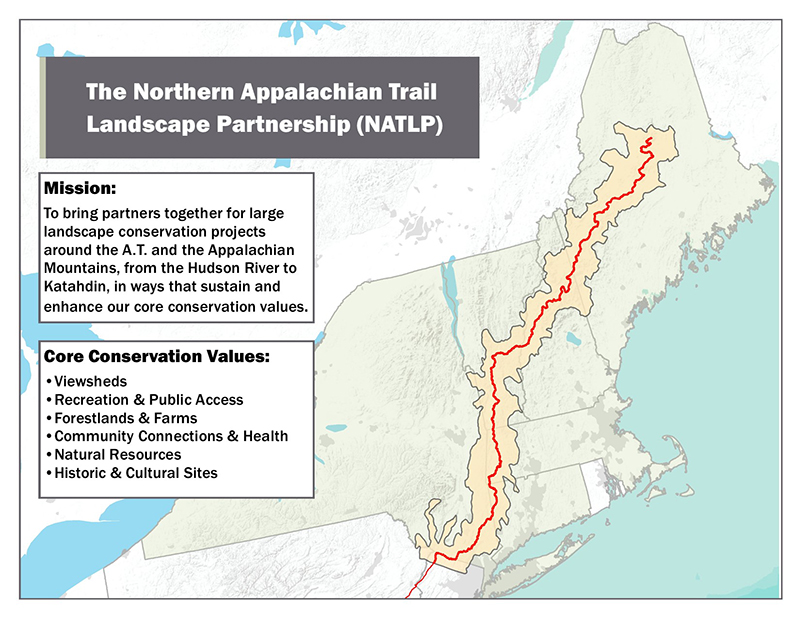If you’ve wanted to raise more conservation funds and engage with a more diverse group of people but your staff is already stretched thin, consider working with your Northern Appalachian Trail Landscape Partnership (NATLP) peers.
Highstead and the Appalachian Trail Conservancy recently hired a coordinator to lead collaborations between Regional Conservation Partnerships (RCPs) and their partners to meet common goals within the Northern Appalachian region from the Hudson River to Katahdin in Maine. The coordinator, Max Olsen, is working with a new steering committee to boost three areas identified as priorities by NATLP members: conservation; justice, equity, diversity, and inclusion; and communications.

“Whether you’re looking for more funding, partners, and expertise for your projects, or to contribute what you can while having a greater impact on shared objectives like biodiversity, climate change, and land justice, joining the Northern A.T. Landscape Partnership may prove to be a force multiplier for you, your organization, and your RCP,” says Bill Labich, RCP Network coordinator.
When RCPs work together and share expertise, connections, and ideas, they see their capacity and reach grow. There’s more federal funding available now than in recent years, such as through the Land and Water Conservation Fund (LWCF).
The LWCF is now permanently financed and, along with two recently passed bills that bring “billions more dollars than the conservation community had access to before,” Olsen says. “We’re faced with a once-in-a-lifetime opportunity. We have the tools and the will.” Network partners, from land trusts to large environmental nonprofits, can look to the NATLP as one avenue to leverage and access this funding.
By working collaboratively with groups representing multiple constituencies and regions, Network members can secure larger grants. Large tasks can be broken down into smaller pieces to make the conservation projects and grant applications more manageable for organizations and more appealing to private and federal funders.
Another priority area, increasing diverse involvement and representation, has begun making inroads. “We need to have a much broader vision of what conservation is and can be,” Olsen says. The partnership is growing and, with guidance from the steering committee, it is creating a more welcoming environment for communities typically ignored or excluded from decision-making processes.
The working group focusing on diversity and inclusion has access to grant funding to pursue how the partnership can more effectively engage and serve Black, Indigenous, and People of Color (BIPOC) communities throughout the region toward achieving shared conservation goals.
An essential first step in forging these relationships is building trust. Trust begins with an acknowledgment of past mistakes and exclusionary practices. “Our partners have established connections and are building relationships,” Olsen says. “We want to be able to pursue conservation efforts that effectively and honestly represent everyone’s values, and we can’t do that unless under-engaged communities are involved.”
Relationship building takes time, especially when the folks involved come from such different backgrounds, but conservation is a common throughline that can bring diverse peoples and perspectives together, he says.
Regardless of your organization’s capacity, whether you want a staff member to serve in a leadership role on a steering committee, as a member of a working group, or as a contributor to a group effort, the NATLP can use your help, Labich says. Raising your hand to join the partnership doesn’t mean falling into a deep hole of commitment. You decide how much or how little time you can give. With three different working groups, Network partners choose where they can best contribute expertise and time.
“There’s new capacity where there wasn’t before,” Labich says. “You’re going to make an impact and access resources you might not otherwise get.”
Plans call for an internal communications committee and the launch this quarter of the conservation and justice, equity, diversity, and inclusion working groups. With the first meetings on the horizon, there is still time to join these working groups, help set an agenda, and contribute ideas about how to advance shared objectives, Olsen says.
“We want to help you succeed in your mission,” Olsen says. “Let’s work together so we can all succeed.”
Reach out to Max Olsen to learn more and see how you can get involved at molsen@appalachiantrail.org. Even if you’re not ready to be a participant in a working group, you can be added to the email list for quarterly updates about partnership work and invitations to bi-annual gatherings.